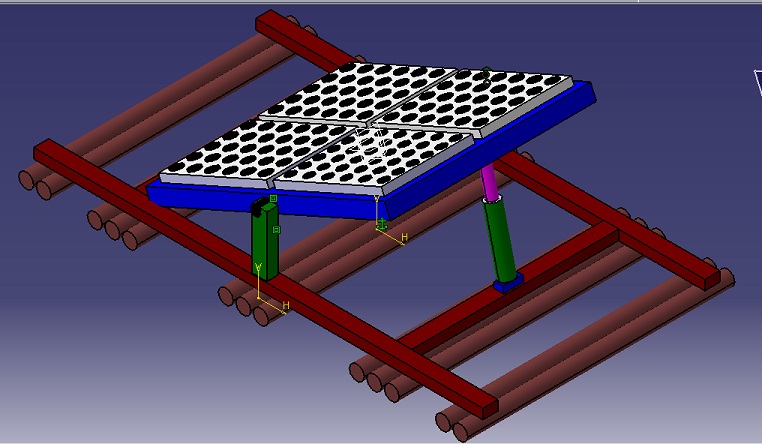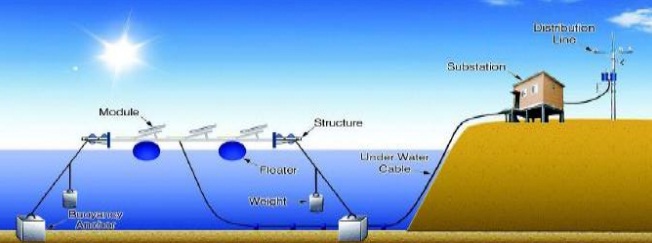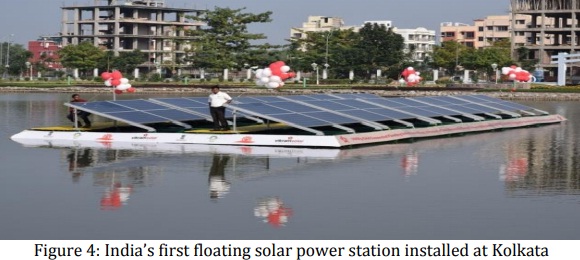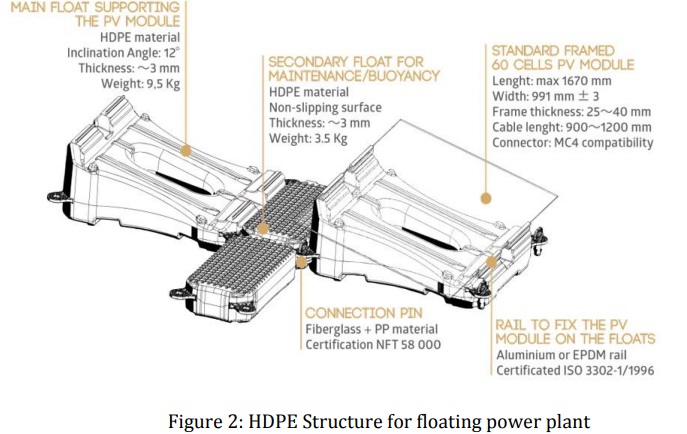





Published on Nov 30, 2023
The constant depletion of the fossil fuels and high energy demand focuses us to renewableenergy sources which are not only the future unlimited source of energy, it is also eco-friendly and sustainable for theenvironment. Even though solar power generation has several advantages over other forms of electricity generation, the major problem is the requirement of land which is scarcely available inthe world and its cost. A new era in solar power i.e., floating solar power plants will solve this issue. This floating solar plant can be installed in any water bodies which will not onlydecrease the cost of the land but also will raise the amount of generation with the cooling effect of water. This paper presents the technical details of floating solar power plants. The floating solar involves solar panels and other components that are fitted onto a platform with hollow plastic or tin drums that enable it to float on water. The benefits of floating power plants will be presented
Recently, the market for solar-energy is expanding due to introduction of the RPS (Renewable Portfolio Standard). Thus, vigorous research is held on alternatives against the lack of sites to install overland PV systems. The floating PV system demonstrated in this paper is a new method of solar-energy generation utilizing water surface available on dams, reservoirs, and other bodies of water. This method has an advantage that allows efficient use of the nation’s soil without bringing damages to the environment, which the pre-existing PV systems cause when it is installed in farmlands or forests. Until 2012, Korea applied REC(Renewable Energy Certificate) value of 1.0 to floating PV systems similar to general PV systems. However, recognizing the technological value and necessity of floating PV systems, Korea has announced that the REC value will be 1.5 for floating PV systems, the same value as BIPV(Building Integrated Photovoltaic System), from year 2013. This paper will briefly introduce the 100kW and 500kW floating PV systems which K-water developed and installed, and analyze its utility compared with overland PV systems on the basis of its generation performance since its installation. Also, effect of wind speed, and waves on floating PV system structure was measured to analyze the effect of the environment on floating PV system generation efficiency.
The main objective was to explore unutilized water bodies and not consume the ever-decreasing land. The requirement was of a solar power generating system that would be suitable for any water body, with the flexibility of being expanded in any other given environment.
It is a new concept for power generation by Solar photovoltaic system installed over the floating technology over water bodies. This technology replaces the installation of photovoltaic power plants over precious land Floating solar power plants installed on water surfaces, so these panels are naturally cooled, due to that the temperature rise of panels is less compared to roof top solar power panels. So the life time of panels increases due to less stress on panels. Floating solar panels cost is slightly higher than the roof top solar panels, but when it comes to scarcity of land problem based countries that floating solar installation cost is negligible with production profits of useful land. The floating solar power system also provides other environmental benefits like prevention of evaporation of water. The systems can also improve water quality. Solar panels acts as roof for the water bodies, so the water will not exposed to sun and atmosphere, it adds a beneficiation for drinking water plants. The organic matter growth such as algae will decrease, as solar panels acts as cover to water.

A PV floating power generation results from the combination of PV plant technology and floating technology. This fusion of new concept consists of Floating System: A floating body (Structure + Floater) that allows the installation of the PV module, Mooring System: Can adjust to water level fluctuations while maintaining its position in a southward direction, PV System: PV generation equipment, similar to electrical junction boxes, that are installed on top of the floating system and Underwater Cable: Transfers the generated power from land to the PV system development. As a new generation technology, it can replace the existing PV plants that are installed on top of woodland, farmland and buildings. Figure 1 shows the outline of the floating solar power plant.

Floating solar power plants installed on water surfaces, so these panels are naturally cooled, due to that the temperature rise of panels is less compared to roof top solar power panels. So the life time of panels increases due to less stress on panels. Floating solar panels cost is slightly higher than the roof top solar panels, but when it comes to scarcity of land problem based countries that floating solar installation cost is negligible with production profits of useful land. The floating solar power system also provides other environmental benefits like prevention of evaporation of water. The systems can also improve water quality. Solar panels acts as roof for the water bodies, so the water will not exposed to sun and atmosphere, it adds a beneficiation for drinking water plants. The organic matter growth such as algae will decrease, as solar panels acts as cover to water bodies. It will minimize the labour cost of water treatment plant maintenance.
The world’s first floating photovoltaic system was installed in 2007 by SPG Solar on a pond at Far Niente Winery in Napa California.[3] It contains1,000 floating panels linked to 1,300 stationary panels on land to produce a total of 4 MW. In Napa of California most of land used for wine fields, so the Floating solar system is chosen to secure the land which is used for power generation. Figure 3 shows the picture of world first solar power plant. Indias first floating solar power station was installed at pond of Victoria Memorial. A raft like platform fitted with hollow plastic or tin drums would be floating on water. The power generating equipment such as solar panels would be fitted on this raft so that they can float on water. This system would be able to generate 10 KW of power and would require an area of around 100 sq metres. The project was funded by ministry of power and renewable energy, it would be the first floating power system project in India. The cost of the project is 32 lakh rupees sanctioned by ministry power and renewable energy sources. The project was commissioned by VikramSolar's in cooperation with the Arka Renewable Energy College in Kolkata.

The installation is completely flexible and consists of ten one kW fibre glass modules, which make up the floating platform itself. The system is firmly anchored to the bottom of the lake and is connected to the grid using a submersible cable. The overall system is designed to last for 25 years and produce a minimum generation of 14 MWh/year. Fig 4 shows India’s first floating solar power station will be launched in one of the Victoria Memorial’s ponds commissioned in 2014
The structure should easily adapt to changes in water level in reservoirs. i.e irrespective of water levels the system, should float on the water bodies. The floating material should be completely recyclable. The characteristics of these structures should be:
The material used for structure should be completely non toxic, resistant to salt water and alkalis acids, UV rays resistant and completely recyclable.
The structures should be able to withstand temperatures from -60°C to 80°C.
Long life time that is 30 years withstand capability under water.
Main materials for the modules of structures are Plastic float elements and stainless steel elements. The plastic structures are made by LUPOLEN 5261Z or PEAD materials which are used for construction of jetties both in marine and military fields. The Cost of PEAD material is high. The other material suitable for floating solar system is HDPE (High Density Poly Ethylene) material. These HDPE structures are preferred due to their low cost and high reliability. The other type of structures is metal support structures for photovoltaic panels, they are made of tubular zinc made paint or stainless steel sections. The cost of metal structures is high and the other drawbacks of these metal bodies are less resistive to alkalis acids. Due to drawbacks and cost considerations of other materials HDPE [4] material is most commonly used material for the floating solar systems. High Density polyethylene structure is shown in figure.2. It allows standard PV panels to be installed on large bodies of water such as drinking water reservoirs, quarry lakes, irrigation canals or remediation and tailing ponds. The Life time of HDPE structures of floating solar power plants is more than 20 years.

Floating Solar is proud to have successfully completed the installations of India’s first ever floating solar power plant. The overall system is designed to last few years and generate a Electrical power as per plant capacity.
Having already started on their plan to install 50 megawatt (MW) solar plants on top of several canals, India has taken the creative use of space one step further and is planning on floating a power station on one of the large stretches of water in Kerala, a state in south-western India. This floating solar power technology was developed by India's Renewable Energy College and the plant is being built by Indian energy company, the National Hydro Power Corporation (NHPC).
With the advancement in solar photovoltaic system, the floating solar power plant plays a vital role. The advantage of the floating system is reduction of evaporation, thus helping preserve water levels during extreme summer. When panels are installed on floating platform, the heating problem of solar panel on land is solved to a great extent. This floating technology is long-lasting, cost effective, flexible and less time for installation. The advantages and technical details of floating solar power plant are presented in this paper. With this advancement, country like India can meet its power demand in future.
1. Photovoltaics: Basic Design Principles and Components‖ This document was produced for the U.S. Department of Energy (DOE) by the National Renewable Energy Laboratory (NREL), a DOE national laboratory. DOE/GO-10097-377,FS 231,March 1997
2. Mr.SamujjalGanguly ―Renewable Energy and Floating Solar Power Plants‖ Vice President Projects, Vikram solar.Energeticaindia · AGO14.
3. Data for largest power plant from link:http://floating-solarsystem.blogspot.in/2013/08/the-inauguration-of-worlds- largest.html
4. “HDPE Pipe for Water Distribution and Transmission Applications” by plastics Pipe Institute, Inc.).PPI.Nov 2009, The Plastics Pipe Institute